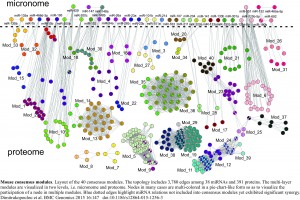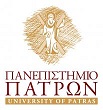Publication
Konstantina Dimitrakopoulou, , Aristidis G. Vrahatis and Anastasios Bezerianos: Integromics network meta-analysis on cardiac aging offers robust multi-layer modular signatures and reveals micronome synergism. BMC Genomics, March 2015, 16:(1): 147.
Abstract
Background
The avalanche of integromics and panomics approaches shifted the deciphering of aging mechanisms from single molecular entities to communities of them. In this orientation, we explore the cardiac aging mechanisms – risk factor for multiple cardiovascular diseases – by capturing the micronome synergism and detecting longevity signatures in the form of communities (modules).
For this, we developed a meta-analysis scheme that integrates transcriptome expression data from multiple cardiac-specific independent studies in mouse and human along with proteome and micronome interaction data in the form of multiple independent weighted networks. Modularization of each weighted network produced modules, which in turn were further analyzed so as to define consensus modules across datasets that change substantially during lifespan. Also, we established a metric that determines – from the modular perspective – the synergism of microRNA-microRNA interactions as defined by significantly functionally associated targets.
Results
The meta-analysis provided 40 consensus integromics modules across mouse datasets and revealed microRNA relations with substantial collective action during aging. Three modules were reproducible, based on homology, when mapped against human-derived modules. The respective homologs mainly represent NADH dehydrogenases, ATP synthases, cytochrome oxidases, Ras GTPases and ribosomal proteins. Among various observations, we corroborate to the involvement of miR-34a (included in consensus modules) as proposed recently; yet we report that has no synergistic effect. Moving forward, we determined its age-related neighborhood in which HCN3, a known heart pacemaker channel, was included. Also, miR-125a-5p/-351, miR-200c/-429, miR-106b/-17, miR-363/-92b, miR-181b/-181d, miR-19a/-19b, let-7d/-7f, miR-18a/-18b, miR-128/-27b and miR-106a/-291a-3p pairs exhibited significant synergy and their association to aging and/or cardiovascular diseases is supported in many cases by a disease database and previous studies. On the contrary, we suggest that miR-22 has not substantial impact on heart longevity as proposed recently.
Conclusions
We revised several proteins and microRNAs recently implicated in cardiac aging and proposed for the first time modules as signatures. The integromics meta-analysis approach can serve as an efficient subvening signature tool for more-oriented better-designed experiments. It can also promote the combinational multi-target microRNA therapy of age-related cardiovascular diseases along the continuum from prevention to detection, diagnosis, treatment and outcome.
Keywords:
Cardiac aging; microRNA synergism; Module; Integromics network; Meta-analysis

 BMBS
BMBS J. Hopkins University
J. Hopkins University Nat. Univ. Singapore
Nat. Univ. Singapore School of Medicine
School of Medicine Sinapse Institute
Sinapse Institute Summer School 2010
Summer School 2010 SYSGENET
SYSGENET University of Patras
University of Patras